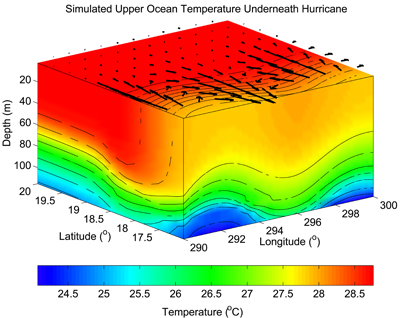Estimation of the drag coefficient from the ocean's response to a hurricane:
A data assimilation approach
By:
Sarah Zedler
UTIG
| When: | Friday, Sept. 09, 2011, 10:30 a.m. to 11:30 a.m. Join us for coffee beginning at 10:00 a.m. |
| Where: | Seminar Conference Room, 10100 Burnet Road, Bldg 196-ROC, Austin, Texas 78758 |
| Host: | Charles Jackson, UTIG |

Abstract
As the wind blows over the ocean, a fraction of the momentum is fluxed beneath the field of surface waves to force motion in the interior. This fraction of proportionality is commonly referred to as the drag coefficient, and is typically parameterized as a function of wind speed. At low to moderate winds, it is well established that the drag coefficient increases monotonically with increasing wind speed.
At very high winds such as encountered in a hurricane, the nature of the air-sea interface changes dramatically, with the presence of breaking waves and resuspended sea spray. This changes the relevant physics determining the drag coefficient, and the relationship with wind speed is less well known. It has been hypothesized that the drag coefficient levels off, or possibly even decreases, as a function of wind speed, for the highest winds.
Several estimates of the drag coefficient at very high wind speeds have been made using atmospheric measurements. This project outlines a method, whereby sea surface temperature and currents are assimilated into a model to find the drag coefficient as a function of wind speed that is most consistent with the upper ocean response to a hurricane. The results we present here are for a classic twin experiment, whereby the "data" are extracted from a reference forward run.




